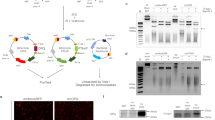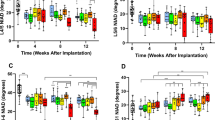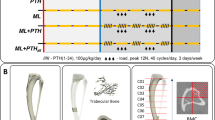Abstract
Various cytokines and cytokine antagonists hold promise as new therapeutic agents for osteoporosis, but their application is hindered by delivery problems. Gene transfer offers an attractive technology with which to obviate these restrictions. Its utility was evaluated in an animal model of osteoporosis. Disease was induced by surgical ovariectomy and monitored by measuring bone weight after 12 days, and by histomorphometry after 5 weeks. Genes were transferred to the mice by intramedullary injection of adenoviral vectors. LacZ and luciferase marker genes were used to identify the bone marrow cells transduced by this procedure, and to track the possible spread of transgenes to other organs. The effect on bone loss of transferring a cDNA encoding the human interleukin-1 receptor antagonist (IL-1Ra) was then evaluated. The intramedullary injection of adenoviral vectors transduced lining osteoblasts, osteocytes and cells within the bone marrow. Luciferase activity persisted within the injected femora and adjacent musculature for at least 3 weeks, and in the draining lymph nodes for 2 weeks. Transient, low level expression was present in the liver, but no luciferase was detected at any time in the lung or spleen. Intramedullary introduction of the IL-1Ra gene resulted in circulation of the corresponding protein at concentrations that peaked on day 3, and returned to baseline by day 12. Transfer of the IL-1Ra gene strongly reduced the early loss of bone mass occurring in response to ovariectomy. Furthermore, it completely inhibited the loss of matrix detected by histomorphometry at 5 weeks. The protective effect of this gene was not restricted to bones receiving intramedullary injection of the vector, but occurred in all bones that were evaluated. This proof of concept encourages further development of gene therapy approaches to the treatment of osteoporosis.
This is a preview of subscription content, access via your institution
Access options
Subscribe to this journal
Receive 12 print issues and online access
$259.00 per year
only $21.58 per issue
Buy this article
- Purchase on Springer Link
- Instant access to full article PDF
Prices may be subject to local taxes which are calculated during checkout







Similar content being viewed by others
References
Pacifici R . Estrogen, cytokines, and pathogenesis of postmenopausal osteoporosis J Bone Miner Res 1996 11: 1043–1051
Gowen M et al. An interleukin 1 like factor stimulates bone resorption in vitro Nature 1983 306: 378–380
Boyce BF et al. Effects of interleukin-1 on bone turnover in normal mice Endocrinology 1989 125: 1142–1150
Lerner UH, Ohlin A . Tumor necrosis factors alpha and beta can stimulate bone resorption in cultured mouse calvariae by a prostaglandin-independent mechanism J Bone Miner Res 1993 8: 147–155
Pacifici R et al. Effect of surgical menopause and estrogen replacement on cytokine release from human blood mononuclear cells Proc Natl Acad Sci USA 1991 88: 5134–5138
Pacifici R et al. Ovarian steroid treatment blocks a postmenopausal increase in blood monocyte interleukin 1 release Proc Natl Acad Sci USA 1989 86: 2398–2402
Ralston SH . Analysis of gene expression in human bone biopsies by polymerase chain reaction: evidence for enhanced cytokine expression in postmenopausal osteoporosis J Bone Miner Res 1994 9: 883–890
Ralston SH, Russell RG, Gowen M . Estrogen inhibits release of tumor necrosis factor from peripheral blood mononuclear cells in postmenopausal women J Bone Miner Res 1990 5: 983–988
Pfeilschifter J et al. Interleukin-1 and tumor necrosis factor stimulate the formation of human osteoclastlike cells in vitro J Bone Miner Res 1989 4: 113–118
van der Pluijm G et al. Two distinct effects of recombinant human tumor necrosis factor-alpha on osteoclast development and subsequent resorption of mineralized matrix Endocrinology 1991 129: 1596–1604
Suda T, Takahashi N, Martin TJ . Modulation of osteoclast differentiation Endocr Rev 1992 13: 66–80
Kitazawa R et al. Interleukin-1 receptor antagonist and tumor necrosis factor binding protein decrease osteoclast formation and bone resorption in ovariectomized mice J Clin Invest 1994 94: 2397–2406
Kimble RB et al. Interleukin-1 receptor antagonist decreases bone loss and bone resorption in ovariectomized rats J Clin Invest 1994 93: 1959–1967
Kimble RB, Bain S, Pacifici R . The functional block of TNF but not of IL-6 prevents bone loss in ovariectomized mice J Bone Miner Res 1997 12: 935–941
Ammann P et al. Transgenic mice expressing soluble tumor necrosis factor-receptor are protected against bone loss caused by estrogen deficiency J Clin Invest 1997 99: 1699–1703
Lorenzo JA et al. Mice lacking the type I interleukin-1 receptor do not lose bone mass after ovariectomy Endocrinology 1998 139: 3022–3025
Kimble RB et al. Simultaneous block of interleukin-1 and tumor necrosis factor is required to completely prevent bone loss in the early postovariectomy period Endocrinology 1995 136: 3054–3061
Evans CH, Robbins PD . Possible orthopaedic applications of gene therapy J Bone Joint Surg Am 1995 77: 1103–1114
Evans CH, Robbins PD . Gene therapy in orthopaedics Orthop Nursing 2000 19: 16–22
Bandara G et al. Intraarticular expression of biologically active interleukin 1-receptor- antagonist protein by ex vivo gene transfer Proc Natl Acad Sci USA 1993 90: 10764–10768
Gerich TG et al. Gene transfer to the rabbit patellar tendon: potential for genetic enhancement of tendon and ligament healing Gene Therapy 1996 3: 1089–1093
Kang R et al. Ex vivo gene transfer to chondrocytes in full-thickness articular cartilage defects: a feasibility study Osteoarthritis Cartilage 1997 5: 139–143
Balk ML et al. Effect of rhBMP-2 on the osteogenic potential of bone marrow stromal cells from an osteogenesis imperfecta mouse (oim) Bone 1997 21: 7–15
Baltzer AW et al. Genetic enhancement of fracture repair: healing of an experimental segmental defect by adenoviral transfer of the BMP-2 gene Gene Therapy 2000 7: 734–739
Goto H et al. Transfer of lacZ marker gene to the meniscus J Bone Joint Surg Am 1999 81: 918–925
Evans CH et al. Clinical trial to assess the safety, feasibility, and efficacy of transferring a potentially anti-arthritic cytokine gene to human joints with rheumatoid arthritis Hum Gene Ther 1996 7: 1261–1280
Gough A et al. Osteoclastic activation is the principal mechanism leading to secondary osteoporosis in rheumatoid arthritis J Rheumatol 1998 25: 1282–1289
Oyama M et al. Retrovirally transduced bone marrow stromal cells isolated from a mouse model of human osteogenesis imperfecta (oim) persist in bone and retain the ability to form cartilage and bone after extended passaging Gene Therapy 1999 6: 321–329
Baltzer AW et al. Adenoviral transduction of human osteoblastic cell cultures: a new perspective for gene therapy of bone diseases Acta Orthop Scand 1999 70: 419–424
Takahashi T et al. A potential molecular approach to ex vivo hematopoietic expansion with recombinant epidermal growth factor receptor-expressing adenovirus vector Blood 1998 91: 4509–4515
Foley R et al. Intramarrow cytokine gene transfer by adenoviral vectors in dogs Hum Gene Ther 1997 8: 545–553
Bolon B et al. Adenoviral delivery of osteoprotegerin ameliorates bone resorption in a mouse ovariectomy model of osteoporosis Mol Ther 2001 3: 197–205
Fang J et al. Stimulation of new bone formation by direct transfer of osteogenic plasmid genes Proc Natl Acad Sci USA 1996 93: 5753–5758
Bonadio J, Smiley E, Patil P, Goldstein S . Localized direct plasmid gene delivery in vivo: prolonged therapy results in reproducible tissue regeneration Nat Med 1999 5: 753–759
Lieberman JR et al. Regional gene therapy with a BMP-2-producing murine stromal cell line induces heterotopic and orthotopic bone formation in rodents J Orthop Res 1998 16: 330–339
Lieberman JR et al. The effect of regional gene therapy with bone morphogenetic protein-2- producing bone-marrow cells on the repair of segmental femoral defects in rats J Bone Joint Surg Am 1999 81: 905–917
Baltzer AW et al. A gene therapy approach to accelerating bone healing. Evaluation of gene expression in a New Zealand white rabbit model Knee Surg Sports Traumatol Arthrosc 1999 7: 197–202
Caplan AI . Mesenchymal stem cells J Orthop Res 1991 9: 641–650
Pittenger MF et al. Multilineage potential of adult human mesenchymal stem cells Science 1999 284: 143–147
Vesterby A et al. Biologically meaningful determinants of the in vitro strength of lumbar vertebrae Bone 1991 12: 219–224
Castellote A, Torres A, Whyte J, Sarrat R . Contribution to the morphological knowledge of the articulations of the human tympanic ossicular chain Acta Otorrinolaringol Esp 1997 48: 269–274
Ghivizzani SC et al. Direct adenovirus-mediated gene transfer of interleukin 1 and tumor necrosis factor alpha soluble receptors to rabbit knees with experimental arthritis has local and distal anti-arthritic effects Proc Natl Acad Sci USA 1998 95: 4613–4618
Author information
Authors and Affiliations
Rights and permissions
About this article
Cite this article
Baltzer, A., Whalen, J., Wooley, P. et al. Gene therapy for osteoporosis: evaluation in a murine ovariectomy model. Gene Ther 8, 1770–1776 (2001). https://doi.org/10.1038/sj.gt.3301594
Received:
Accepted:
Published:
Issue Date:
DOI: https://doi.org/10.1038/sj.gt.3301594
Keywords
This article is cited by
-
Bone regeneration in osteoporosis: opportunities and challenges
Drug Delivery and Translational Research (2023)
-
Inflammasomes and the IL-1 Family in Bone Homeostasis and Disease
Current Osteoporosis Reports (2022)
-
New horizons in treatment of osteoporosis
DARU Journal of Pharmaceutical Sciences (2017)
-
Inflammatory bone loss: pathogenesis and therapeutic intervention
Nature Reviews Drug Discovery (2012)
-
Orthopedic Gene Therapy in 2008
Molecular Therapy (2009)



